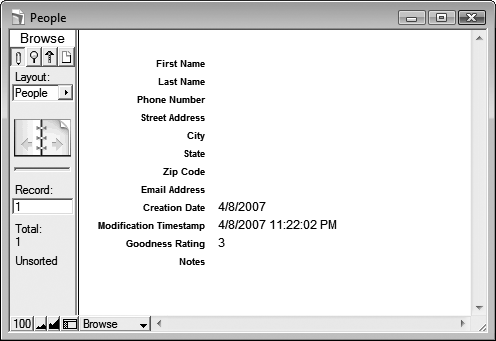In the last chapter you created your first database, and it really works. Unfortunately, it doesn’t look all that great. For example, the Street Address field is the same width as the State field, even though street addresses are usually much longer than state names. The Goodness Rating field is much longer than it needs to be. And unless you’re a real minimalist, the whole thing just looks boring (see Figure 4-1).
Figure 4-1. This database works, but it could work—and look—better. What if you want to see lots of people at once? What if you want to print address labels for all these people? What if you want to arrange these fields in logical groups so they’re easier to figure out? This database can’t do any of those things, but if you give it a few new layouts, you can do all of them—and lots more.
There are other things to worry about as well. There’s no good way to see lots of people at one time—in a nice list, for example. A list would also be handy for printing. As it stands, you have to print a whole page for each person in the database if you want a hard copy.
The FileMaker concept of layouts solves all these problems and more. While the Manage Database window lets you define the structure of your database (its fields and tables), layouts let you design the look and feel.
Get FileMaker Pro 9: The Missing Manual now with the O’Reilly learning platform.
O’Reilly members experience books, live events, courses curated by job role, and more from O’Reilly and nearly 200 top publishers.


